Southern Twayblade - Listera australis
|
Listera australis - Southern Twayblade. Listera australis is now a synonym of Neottia bifolia. Based on recent molecular studies, scientists have determined that Listera and Neottia have common ancestors, and therefore should be in the same genus. This is in spite of Neottia being without chlorophyll, relying on fungi for food production, while Listera plants are chlorophyllic, thus producing their nutrition via photosynthesis. Since Neottia is an older name, it won out over Listera. Maybe I'm just recalcitrant, but I think chlorophyllic/non-chlorophyllic is enough for separation of the species into different genera, so I'm sticking with Listera australis until the rest of the world publications are updated.
Southern Twayblade is a diminutive plant of damp forest areas and open bogs from Texas and Florida north to Pennsylvania, New York, and Vermont. It is listed as Endangered or Threatened in Florida, Kentucky, New York, Pennsylvania, Tennessee, and Vermont, although due to its coloration and tiny size it may be more widespread than verified records indicate. It is possibly extirpated in Kentucky.
Found in:
AL, AR, DC, DE, FL, GA, KY, LA, MD, MS, NC, NJ, NY, OK, PA, SC, TN, TX, VA, VT
Leave comments on Listera australis at this link. | 
Distribution of Listera australis in the United States and Canada:
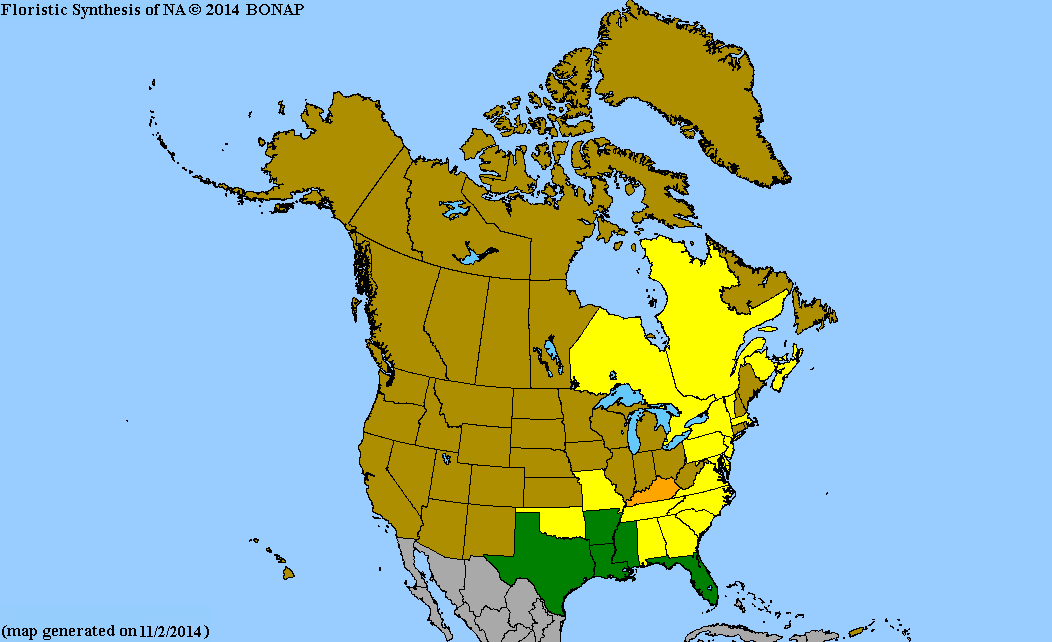
Map courtesy of The Biota of North America Program.
Map color key
Search Our Database: Enter any portion of the Scientific, Common Name, or both.
Do a general Google search of the entire site:
#ad
 Follow USWildflowers on Twitter
#ad
| | Site: Wolf Creek Trout Lily Preserve, Grady County, Ga Date: 2014-February-20 | Photographer: Gerald C. Williamson
Nikon D7000
Tamron SP 90MM f/2.8 AF Macro | In spite of the tiny .25 inch size of the flower, when I first saw the blossom on this plant, I thought "no wonder it is called Twayblade" due to the elongated lobes of the median petal - subsequently finding that the name refers to the pair of leaves rather than the striking flower.
The flowers can be various colors, from the brownish-red (purplish?) shown here, to a more pink color, to a yellowish-green.
The blossom has, depending on your preference, 6 tepals in two whorls, or 3 petals and 3 sepals. Since petal/sepal makes it easier to describe, I will use that paradigm with the two flowers in the two blossom closeup photos here (both crops from the same photograph). The median (bottom) petal has two very elongated, linear lower lobes which project more than half the length of the petal. There is a small tooth where the lobes join. There are two upper lobes on this petal which partially surround the column. | | 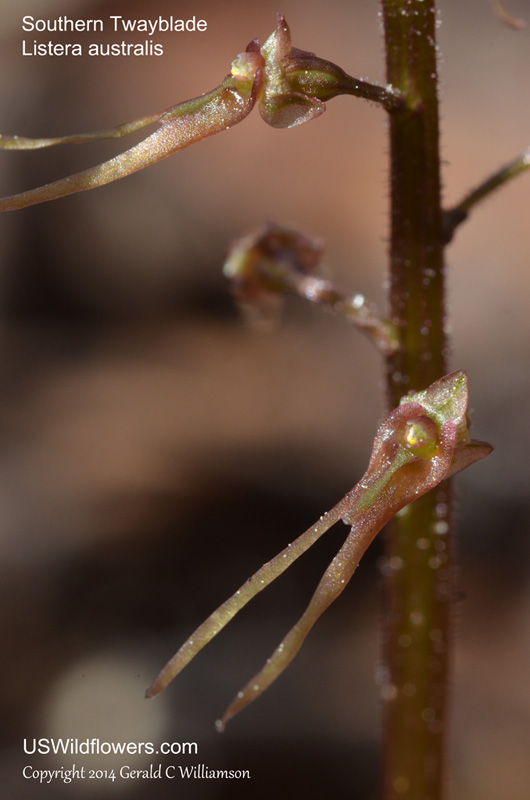
| | Site: Wolf Creek Trout Lily Preserve, Grady County, Ga Date: 2014-February-20 | Photographer: Gerald C Williamson
Nikon D7000 | | The sepals are concave, ovate, obtuse, and reflexed, but not as reflexed as the lateral petals. The lateral petals are extremely reflexed, wrapping back around the lower margins of the sepals. Flora of North America says the pedicel and ovary are glabrous, but this photo shows a glabrous ovary and a pedicel that is at least partially glandular-hairy. | | Click on the photo for a larger image
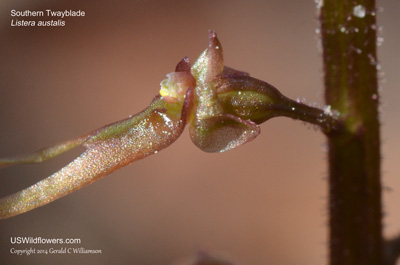
| | Site: Wolf Creek Trout Lily Preserve, Grady County, Ga Date: 2014-February-20 | Photographer: Gerald C Williamson
Nikon D7000 | | The inflorescence of Southern Twayblade is a raceme with (usually) 5 to 25 flowers. The peduncle (beginning at the leaves) is slightly glandular-hairy, the rachis more so. While Flora of North America indicates the stem (below the leaves) is glabrous, at least one of my photos shows some slight glanduarity on the stem. | | Click on the photo for a larger image
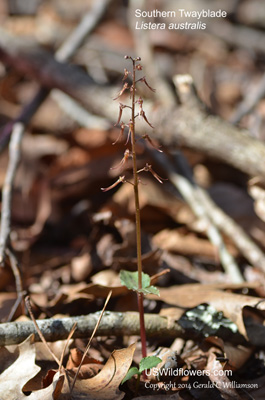
| | Site: Wolf Creek Trout Lily Preserve, Grady County, Ga Date: 2014-February-20 | Photographer: Gerald C Williamson
Nikon D7000 | | While appearing to be mid-stem, according to the highly respected Flora of North America, the pair (rarely 3) of opposite (occasionally sub-opposite) leaves on Listera (Neottia) species are at the apex of the stem - the purple-green stem is below the leaves, and the peduncle begins at and is above the 2 leaves. It is this pair of leaves that provides the Twayblade common name. There are also 2 (rarely 3) bracts enclosing the base of the stem, barely visible in the shade in this photo. Also visible at the peduncle/pedicel juncture of the lowest flower in this photo is the tiny floral bract. | | Click on the photo for a larger image
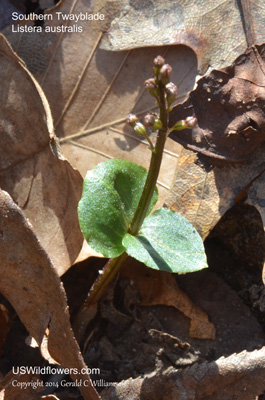
| | Site: Wolf Creek Trout Lily Preserve, Grady County, Ga Date: 2014-February-20 | Photographer: Gerald C Williamson
Nikon D7000 | | Listera australis (Neottia bifolia) is truly a tiny plant, rarely more than 10 inches tall, and usually shorter. The plant in this photo is about 3 inches tall. Due to the diminuitive size and coloration of the plant and its flowers, it is very difficult to spot (I would have missed the colony if it were not marked by the folks running the Wolf Creek Trout Lily Preserve), and therefore is probably much more widely distributed than is indicated by verified sightings. Flora of North America and the New England Wild Flower Society report as being in 4 fewer states than do the USDA and other sources. | | Click on the photo for a larger image
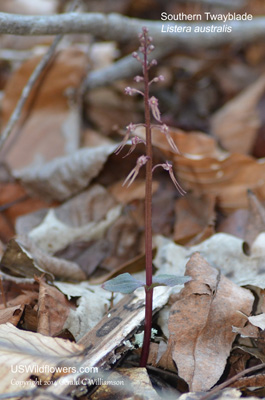
|
References used for identification and information:
|
|
| |
| #ad
|
|







